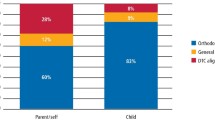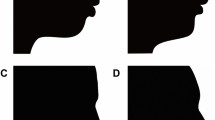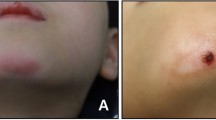Abstract
Data sources
The Cochrane Oral Health Group's Trials Register, the Cochrane Central Register of Controlled Trials (CENTRAL), Medline and Embase databases were searched.
Study selection
Randomised controlled trials of orthodontic treatments to correct prominent lower front teeth.
Data extraction and synthesis
Study screening and data extraction and risk of bias assessment were carried out independently by two reviewers. Meta-analysis was only undertaken when studies of similar comparisons reported comparable outcome measures.
Results
Seven RCTs with a total of 339 participants were included in this review. Three studies were at high risk of bias, three unclear and one at low risk. Four studies reported on the use of a facemask, two on the chin cup, one on the tandem traction bow appliance, and one on mandibular headgear. One study reported on both the chin cup and mandibular headgear appliances.
One study (n = 73, low quality evidence), comparing a facemask to no treatment, reported a mean difference (MD) in overjet of 4.10 mm (95% confidence interval (CI) 3.04 to 5.16; P value < 0.0001) favouring the facemask treatment. Two studies comparing facemasks to untreated control did not report the outcome of overjet. Three studies (n = 155, low quality evidence) reported ANB (an angular measurement relating the positions of the top and bottom jaws) differences immediately after treatment with a facemask when compared to an untreated control. The pooled data showed a statistically significant MD in ANB in favour of the facemask of 3.93° (95% CI 3.46 to 4.39; P value < 0.0001). There was significant heterogeneity between these studies (I2 = 82%). This is likely to have been caused by the different populations studied and the different ages at the time of treatment.
One study (n = 73, low quality evidence) reported outcomes of the use of the facemask compared to an untreated control at three years follow-up. This study showed that improvements in overjet and ANB were still present three years post-treatment. In this study, adverse effects were reported, but due to the low prevalence of temporomandibular (TMJ) signs and symptoms no analysis was undertaken.
Two studies (n = 90, low quality evidence) compared the chin cup with an untreated control. Both studies found a statistically significant improvement in ANB, and one study also found an improvement in the Wits appraisal. Data from these two studies were not suitable for pooling.
A single study of the tandem traction bow appliance compared to untreated control (n = 30, very low quality evidence) showed a statistically significant difference in both overjet and ANB favouring the intervention group.
Conclusions
There is some evidence that the use of a facemask to correct prominent lower front teeth in children is effective when compared to no treatment on a short-term basis. However, in view of the general poor quality of the included studies, these results should be viewed with caution. Further randomised controlled trials with long follow-up are required.
Similar content being viewed by others
Log in or create a free account to read this content
Gain free access to this article, as well as selected content from this journal and more on nature.com
or
References
Anne Mandall N, Cousley R, DiBiase A, et al. Is early class III protraction facemask treatment effective? A multicentre, randomized, controlled trial: 3-year follow up. J Orthod 2012; 39: 176–185.
Author information
Authors and Affiliations
Additional information
Address for correspondence: Luisa Fernandez Mauleffinch, Review Group Co-ordinator, Cochrane Oral Health Group, MANDEC, School of Dentistry, University of Manchester, Higher Cambridge Street, Manchester, M15 6FH, UK. E-mail: luisa.fernandez@manchester.ac.uk
Watkinson S, Harrison JE, Furness S, Worthington HV. Orthodontic treatment for prominent lower front teeth (Class III malocclusion) in children. Cochrane Database Syst Rev 2013; 9: Art. No. CD003451. DOI: 10.1002/14651858.CD003451.pub2.
This paper is based on a Cochrane Review published in the Cochrane Library 2013, issue 9 (see www.thecochranelibrary.com for information). Cochrane Reviews are regularly updated as new evidence emerges and in response to feedback, and the Cochrane Library should be consulted for the most recent version of the review.
Rights and permissions
About this article
Cite this article
Shadrick, V., Walker, M. Facemask therapy between ages six to ten years may lead to short term improvements for Class III malocclusions. Evid Based Dent 14, 112–113 (2013). https://doi.org/10.1038/sj.ebd.6400969
Published:
Issue date:
DOI: https://doi.org/10.1038/sj.ebd.6400969
This article is cited by
-
Dental compensation for skeletal Class III malocclusion by isolated extraction of mandibular teeth
Journal of Orofacial Orthopedics / Fortschritte der Kieferorthopädie (2015)



